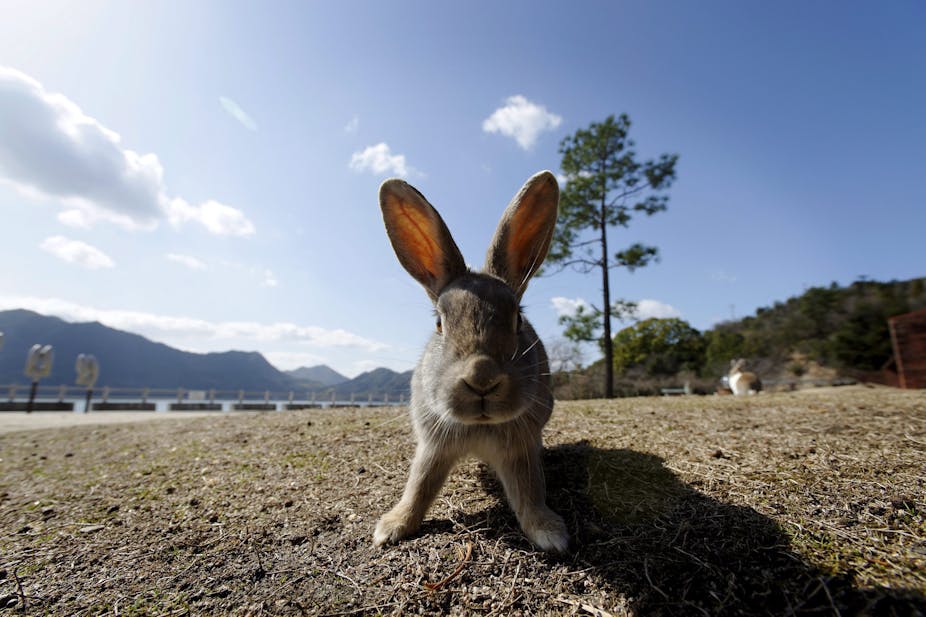Rabbit-killing viruses - first myxoma, then rabbit haemorrhagic disease - have rid many of our landscapes of rabbits and lulled Australians into a false sense of security. Rabbits are now fighting back, but we seem to have lost the rabbit-control skills we once had. Can we regain them in time to stop another plague?
Wild European rabbits were introduced into Australia in 1859 and quickly established and spread. Huge numbers caused serious economic losses, initiating major efforts to stop them, but even the heroic “rabbit-proof” fences in Western Australia were to no avail.
Within 70 years rabbits dominated two-thirds of the continent, in habitats ranging from Mount Kosciusko’s snows to Lake Eyre’s saline edge. Only the monsoonal tropics remained free.
Farmers and graziers battled the problem, fencing their properties with “one-inch” netting, using strychnine and arsenic, digging out warrens or fumigating them with cyanide flakes or fiery contraptions that produced carbon-monoxide. However, these measures were rarely used consistently enough to keep farms rabbit-free.
CSIRO’s release of the myxoma virus in 1950 produced the first break-through. This virus, a benign parasite of the Brazilian forest rabbit, was highly lethal for European rabbits. It quickly reduced Australia’s rabbits to a mere 5% of former numbers.
This had enormous consequences for primary production. The immediate annual benefit for the wool and beef industries, for example, was equivalent to $1.9 billion in 2010 terms.
Nonetheless, this solution was not long-lasting. Within a decade, the myxoma virus had attenuated and rabbits showed genetic resistance to the disease. Despite exhortations from CSIRO for landholders to use innovative control methods such as 1080 poisoning, rabbit populations and economic problems rose.
Increasingly, rabbits limited farm production and the costs of their control mounted.
The myxoma virus appeared unique in terms of its use against a pest mammal. But, against the odds, a second chance was provided when rabbit haemorrhagic disease virus (RHDV) spread through wild rabbits in Europe in the late 1980s.

The livestock industries and CSIRO moved fast. By 1995 this new virus had been assessed and deemed safe for use in Australia. Unfortunately, its premature escape from quarantine during trials on Wardang Island, South Australia, got the project off to a shaky start.
Despite this, however, the combination of RHDV with still-active myxoma virus effectively re-set the clock to the 1950s and rabbit numbers plummeted.
The almost rabbit-free decade that followed saw not only substantial economic benefits, but also important ecological advances. Despite occasional insights - such as Francis Ratcliffe’s book “Flying fox and drifting sand”, that described the devastation caused by rabbits in the inland - Australians had paid little attention to the environmental benefits when myxomatosis first spread.
The spread of RHDV revealed, however, that rabbits had been causing terrible damage to native ecosystems. In north-western Victoria, bulokes and native pine suddenly regenerated for the first time since the 1950s when myxoma virus had arrived. In inland Australia, native hopping mice, considered threatened species, became wide-spread as grasses re-established and seed supplies burgeoned.
Nonetheless, these benefits are delicately poised as rabbits return. We know now that self-perpetuating arid-zone ecosystems cannot be maintained if we have more than one rabbit per hectare.
With rabbits developing resistance to this second viral bio-control agent we now have two tasks: encouraging graziers and farmers to take greater action, but also persuading conservation agencies to properly protect ecosystems. These measures include the careful and appropriate use of poisoning, warren destruction and fumigation in an integrated way. We want to maximise effectiveness while reducing risks to wildlife.
As the 16-year holiday from active rabbit control comes to an end it is obvious that there has been tremendous loss of capacity to act. Some of this is due to generational change; present land managers have little experience with rabbits while those who understood rabbits well are no longer in the workforce.
Researchers gave at least eight years warning that rabbits were on the rise. They also provided clear experimental evidence that rabbits were gaining resistance to infection with RHDV; collaborative research with French and German scientists proved an underlying genetic mechanism.
This lead was enough for the Invasive Animals Cooperative Research Centre to support scientists in CSIRO and state agencies to look more closely at the disease. This work has now reached a point where new strains of RHDV from overseas are being assessed for their capacity to counter growing rabbit resistance. The project, called RHD-Boost, has a reasonably good chance of finding virus variants that will override the resistance now developing in Australian rabbits.
Nonetheless, such work takes time. New virus strains may not be cleared for release for several more years. Even then, there is no guarantee that they will completely offset the build-up in rabbit genetic resistance.
Apart from the science, more effort is clearly needed to engage farmers and conservation interests to eliminate rabbits by other means, both for the immediate future and to capitalise on RHD-Boost when the new virus is in place.
We should not squander the benefits of biological controls by expecting them to do all the work. It’s a bit like using penicillin. Despite some bacteria developing resistance, it is remains a very useful antibiotic, but we cannot rely on it alone and ignore other hygiene measures to maintain our health. If we are serious about “bio-security” we should deal with the well-being of our productive land and conservation areas along similar lines.

